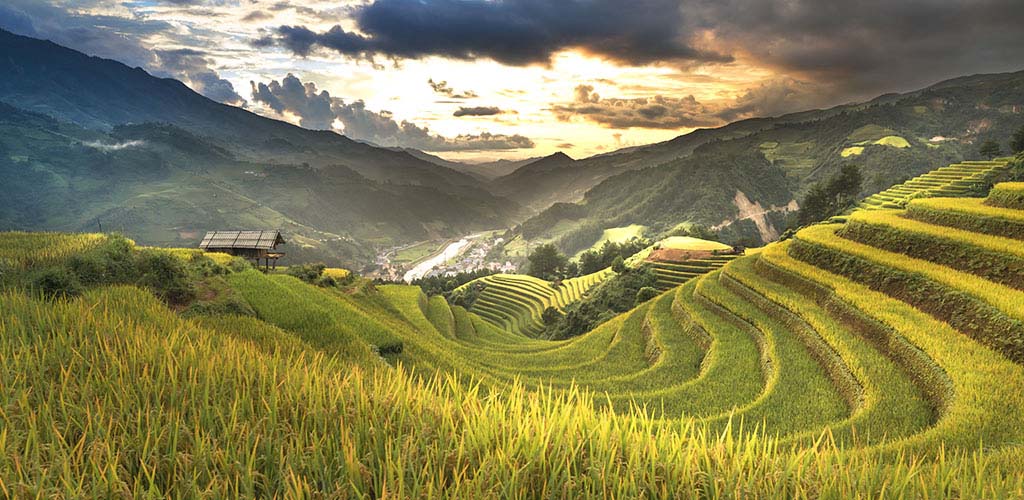SAPA: The Tonkinese Alps
As tourism rapidly expands in Vietnam's more familiar cities along the coast, many traveler's are venturing to more remote areas with a fresher atmosphere. One destination growing in popularity, and soon to be overwhelmed by backpackers, is Sapa. Sapa is a small, tranquil town that lies a mile high on the Hoang Lien Son mountain range along the Chinese border in northwest Vietnam. Nicknamed "the Tonkinese Alps" the area features vaulting rice terraces, lush vegetation and the highest peak in Vietnam, Fansipan, which towers over the village, swirled in fog from across a deep valley.
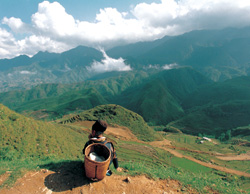
A look off towards China provides breathtaking views of no less than seven mountain ranges. The town was located by Jesuit missionaries in 1918, and, attracted by the cool and temperate climate, western arrivals soon transformed Sapa into a pleasant hill station.
Along with a church, they constructed hotels, tennis courts, an airport, hydro-electric station and summer villas. Most were abandoned or destroyed during the subsequent war for independence with the French and a border skirmish with the Chinese, but some of the colonial influence remains.
Although the name Sapa means "sand village" in Chinese and the town is located within Vietnam, it is home to a wealth of colorful, diverse hilltribes who have steadfastly resisted integration into Vietnamese society and modern life. In fact, the hill tribes, including the Hmong, the Dao, and the Dai, comprise the majority of inhabitants in the area, outnumbering the Vietnamese who have traditionally preferred the warmer climate of the low lands. Indeed, Sapa has been known to get a light sprinkling of snow in the winter.
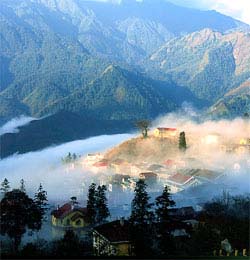
The hill tribes are the real attraction of the area - wearing traditional dress of hand woven and dyed clothes and silver jewelry that make the Vietnamese seem like westerners. They are shy and are wary of foreigners. Usually, only the Hmongs will socialize or let you take a picture. Sapa's most notable site is its central market - a main gathering place for hilltribes from the surrounding villages. Hill tribes congregate there not only to sell handicrafts, jewelry, orchids, mushrooms, and honey, but to also cultivate relations with other groups, play games, and perhaps find a sweetheart. On some weekend evenings, singing courtships and marriages take place.
Diversions include hiking to nearby villages where it is possible to stay overnight, Silver Falls several kilometers north and a difficult, three-day scaling of Fansipan itself. A scenic train ride along the Red River takes all day to reach Lao Cai on the Chinese border. From there it is a short taxi ride straight up a dramatic road to Sapa, eighteen miles away.
Sapa is a comfortable base for exploring the area. Highlights include Vietnam's highest paved pass, local hilltribe villages, and exploration of Sapa's natural wonders and peaceful surroundings. Very cool weather and early morning fog blowing off Qui Ho Lake high above Sapa and cold to freezing weather can be expected between December and February. Preferable weather is in March and April when the coastal areas are sweltering. Accommodations are at a charming colonial style hotel overlooking the breadth of Sapa's mountain range, terraced rice fields, and deep valley. Tourism has yet to hit Sapa, but during a visit last July the road from Lao Cai was being properly paved, and a small trickle of backpackers were beginning to roll in.
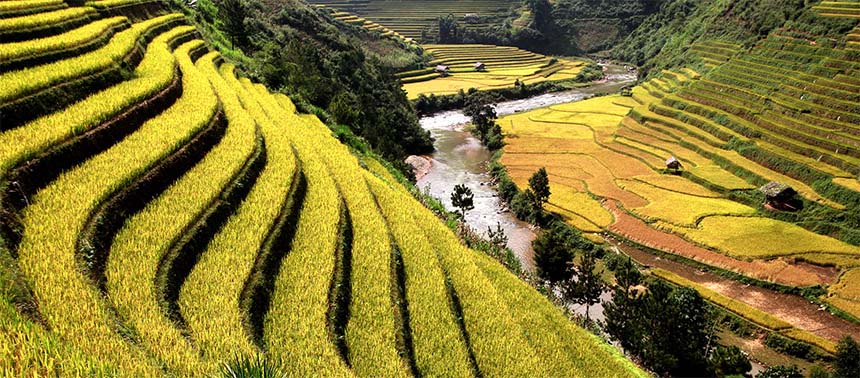
When to go?
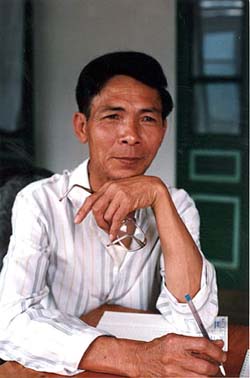
Lying at nearly 4,000 feet and in the farthest north of the country, the weather in Sapa can be the coldest in all Vietnam during winter. From December lasting sometimes through March, temperatures can drop into the 30s with fog off Qui Ho Lake and drizzle blotting out the stunning vistas off into China. However, Late October and November are exceptional, typically warm and it is harvest time, when the terraced rice fields are golden yellow, creating a dazzling sight.
April and May are also better months to journey to Sapa, with clearer skies. If your trip does not fall during the better months of the year, consider the shorter journey to picturesque Mai Chau, only three hours southwest from Hanoi, also rich in a diversity of hilltribes but at lower (and warmer elevation). Mai Chau has excellent light trekking and karst scenery and Cuc Phuong National Park is also nearby (more on Cuc Phuong). Also, more on weather on our weather page.
Dang Trung is the proprietor of the popular Auberge of his name in Sapa. Arriving exhausted on a chilly wet well past midnight during the Winter after pedaling up from Lao Cai into a jet black Sapa (did I mention it was cold and wet?), what few hotels existed were all full. An awakened Dang Trung ushered me into his kitchen, stoked a fire, and cooked a warm restorative meal. He then laid a thick mat of bedding over the very same table I'd just eaten on and bid me goodnight.
In the morning he was busy in the kitchen, cooking for guests and brought over another heaping meal... I wanted to stay forever... A kind, gracious man with an unforgettable quote after I'd asked how he came to speak such excellent English? "Ah, but that is history, let us talk of other things..."
BY PATRICK MORRIS & DANG TRUNG, 1993
PUBLISHED IN LONELY PLANET VIETNAM 1ST ED.
Update on travel to Sapa
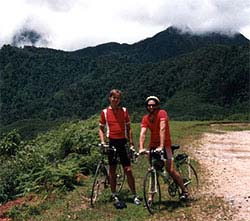
A visit to Sapa, in the heart of the high-altitudes of the Tonkinese Alps, should be planned for the months most pleasant and never during the cold season of Winter, when temperatures can dip below freezing and the high mountain vistas obscured by clouds.
Moreover, if you've limited time in Vietnam, also realize it's a big chunk of time to visit Sapa, including nine hour train rides in each direction. For a place with better weather and more convenient, ask us about Ninh Binh and Mai Chai. Lastly, much has changed since the above article written almost 20 years ago. Sapa now exists and depends on tourists. The mountain vistas are beautiful, but expect tourists to outnumber locals and any hilltribe people in and around Sapa are there to sell goods to travelers.
